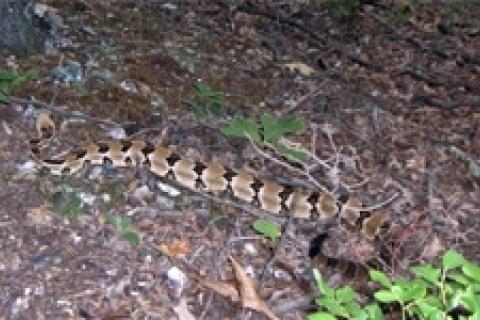
According to the Chinese zodiac, it's the year of the snake. The year is said to be characterized by intelligence and a tendency for corruption. You be the judge. Regardless, it's a good excuse to study up on snakes, especially identification and behaviors of these reptiles so essential to the health of our ecosystem.
 |
| Pit vipers, such as this timber rattlesnake, have elliptical pupils and pits below their eyes. Generally, but not always, heads of poisonous snakes are arrowhead shaped. |
Myths and lore abound about snakes, much of it generated by symbolisms in the Bible. Many Judaeo-Christian beliefs regard snakes as evil, dark serpents. Modern research indicates that snakes, like all wild animals, have their niches where they strive to live and procreate. They prefer flight over fight, but may become aggressive when provoked.
Snake bites are rare and most come from mishandling. However, outdoorsmen should be conscious of the possibility of poisonous snakes in the areas they travel. Missouri has five poisonous species including: the cottonmouth or water moccasin, the Osage copperhead, Timber rattlesnake, Eastern massauga and the Pygmy rattlesnake.
All five species belong to the pit viper family, meaning that they have pits below their eyes, which are heat sensitive organs to help them find prey. The poisonous species also have arrowhead shaped heads. So do some non-poisonous species, but the arrowhead shape is less distinct. The pupils of poisonous snakes are also elliptical.
The cottonmouth is the most feared of the five Missouri poisonous snakes and accounts from 6.6 percent of snake bite related deaths in the United States. This heavy-bodied, dark colored snake is also known for having a short temper. Found in swamps of southeast Missouri and rivers of the Ozarks, anyone being bitten should seek immediate medical attention.
Banded water snakes are common in much of the cottonmouth's territory and often mistaken for water moccasins. Water snakes also have short tempers, but they have short teeth and leave a telltale u-shaped bite, rather than the two puncture marks from the fangs of a cottonmouth. Water snakes do sometimes have the nasty habit of hanging on and making a chewing motion once they bite. The scare is far worse than the bite, however.
The three species of rattlesnakes found in Missouri are similar in appearance, yet inhabit different areas of the state. The Timber rattler is found primarily in the heavily forested areas of southern Missouri, while the Massauga is found in a few northern counties in moist prairies and marshes. The Northern pygmy rattler is the smallest of the three and inhabits rocky, open areas and glades of southern Missouri. All rattlesnakes have the familiar rattles at the end of their tails. However, they do shed rattles and may be without them at times. Outdoorsmen consider the sound of the rattle a a threatening warning. Other species, such as copperheads and black rat snakes will rattle their tails in the leaves, mimicking the sound of a rattler. It is best to err on the side of caution, however.
The Southern copperhead is the most common of the five poisonous species. It is readily identified by the hour glass shaped blotches on its body. This brownish-orange and tan reptile is particularly handsome.
Studying up on snake identification is particularly easy with readily available guides and internet access. Techniques to avoid contact with poisonous snakes is to make lots of noise when hiking, watch where you place hands and feet, don't step over downed logs and know the types of habitats where snakes live.
- 5858 views

